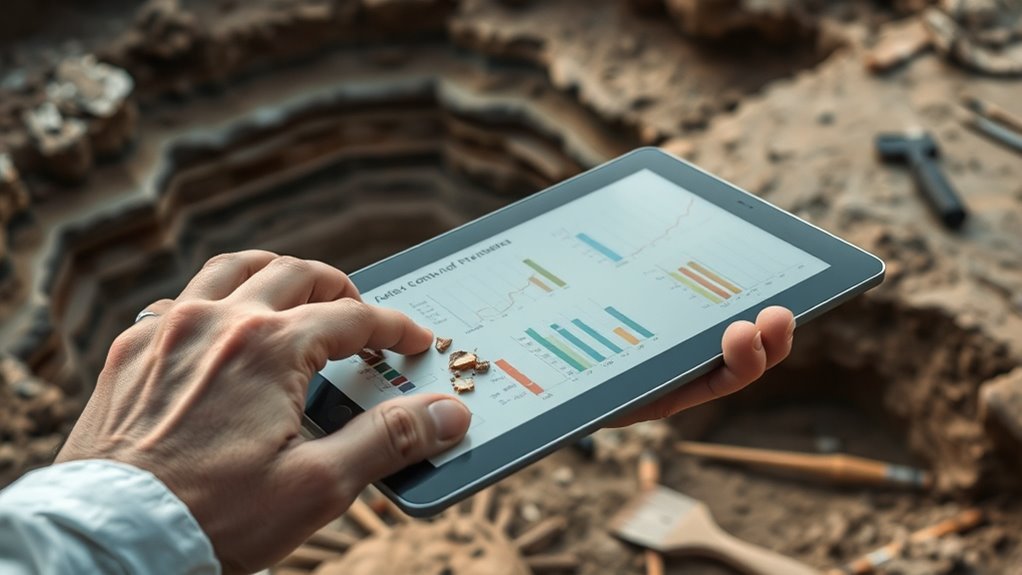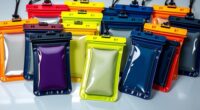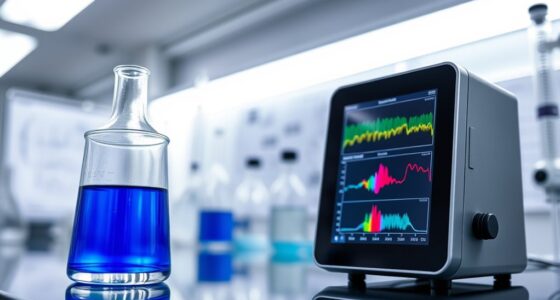Archaeologists use several methods to determine the age of artifacts, helping you understand human history. Radiocarbon dating measures decay of carbon-14 in organic materials, with calibration ensuring accurate results up to about 50,000 years. Thermoluminescence, on the other hand, dates ceramics and heated stones by measuring emitted light since last heating. Both techniques use sophisticated tools to piece together timelines, revealing the stories behind ancient peoples, and if you keep exploring, you’ll see how these methods fit together to access the past.
Key Takeaways
- Dating methods like radiocarbon and thermoluminescence reveal the age of artifacts and sites, helping reconstruct human history.
- Radiocarbon dating measures carbon-14 decay in organic materials and requires calibration for accuracy.
- Calibration uses tree rings and other well-dated samples to convert radiocarbon data into calendar years.
- Thermoluminescence dates ceramics and heated stones by measuring emitted light accumulated since last heating.
- Combining these techniques improves reliability and provides a comprehensive understanding of archaeological timelines.

Archaeologists rely on a variety of dating methods to determine the age of artifacts and sites. These methods help you piece together human history, revealing when ancient peoples lived and how they interacted with their environment. One fundamental technique is radiocarbon dating, which measures the decay of carbon-14 in organic materials. To get accurate results, you need to perform radiocarbon calibration. This process adjusts raw measurements to account for fluctuations in atmospheric carbon-14 levels over time, ensuring your dates align with calendar years. Without calibration, your estimates could be off by hundreds or thousands of years, leading to misinterpretations of archaeological timelines. Calibration curves, built from data like tree rings and other well-dated samples, serve as your guide in translating radiocarbon measurements into precise ages. This technique is most effective for materials up to about 50,000 years old and is invaluable for dating organic remains like charcoal, bones, and shells. Additionally, advancements in spectrometry techniques have improved the precision and reliability of dating methods across various materials.
Another key method is thermoluminescence techniques, which you use when dating ceramics, burnt stones, or sediments. When these materials are heated or exposed to sunlight, they release stored energy in the form of light. Thermoluminescence measures this emitted light to determine how much radiation the sample has absorbed since its last heating or exposure. The more light emitted during testing, the more recent the heating event. This technique hinges on understanding the mineral’s ability to trap electrons over time, allowing you to estimate the time elapsed since the object was last heated. Thermoluminescence is particularly useful in archaeological contexts where organic materials are absent, offering a way to date pottery shards or fired clay objects precisely. It’s essential to carefully prepare samples, minimize exposure to light, and accurately measure the emitted luminescence to obtain reliable dates.
Both radiocarbon calibration and thermoluminescence techniques exemplify how scientific advancements enhance your ability to interpret the past. They complement each other, extending your dating range across different types of materials and contexts. As you work with these methods, you develop a clearer picture of ancient human activities, migration patterns, and environmental changes. By understanding the principles behind these techniques, you appreciate how modern archaeology transforms fragmented artifacts into coherent stories of human history. Whether calibrating radiocarbon dates for organic remains or analyzing luminescence in ceramics, these methods disclose the secrets buried beneath the surface, helping you connect with the distant past with greater confidence and accuracy.
Frequently Asked Questions
How Accurate Are Radiocarbon Dating Results?
Radiocarbon dating is quite accurate within a range of about 50 to 100 years, but calibration curves help improve precision by adjusting for fluctuations in atmospheric C-14 levels over time. However, your results can be affected by sample contamination, which introduces newer or older carbon and skews dates. Proper sample handling and calibration are essential for reliable results, making radiocarbon dating a valuable tool when used carefully.
Can Dating Methods Determine the Exact Age of Artifacts?
You might think dating methods can pinpoint an artifact’s exact age, but in reality, they often come close yet aren’t perfect. Calibration challenges, like atmospheric changes, and sample preservation issues can cause slight inaccuracies. While techniques like radiocarbon dating give us a very narrow window, they can’t guarantee the precise moment an artifact was made. So, your discoveries are more like a well-educated guess than a crystal-clear timestamp.
What Are the Limitations of Thermoluminescence Dating?
You should know that thermoluminescence dating has limitations, especially with luminescence precision. Variations in natural radiation can affect results, making it less accurate over long periods. Sample contamination is another issue, as it can reset the luminescence signal, leading to inaccurate ages. These factors mean you can’t always rely solely on this method for precise dating, and it’s best used alongside other techniques.
How Do Contamination Issues Affect Dating Accuracy?
Contamination issues can markedly impact dating accuracy because sample contamination introduces extraneous materials that skew results. If lab procedures aren’t strict, contaminants like modern carbon or dirt can mix with your sample, making it seem younger or older than it truly is. To prevent this, you need careful sample handling and strict lab protocols, ensuring only the original materials are measured, which helps maintain the integrity of your dating results.
Are There New Emerging Dating Technologies in Archaeology?
You’ll find that new dating technologies like digital imaging and isotope analysis are transforming archaeology. Digital imaging allows you to examine artifacts in high detail without damage, while isotope analysis helps you determine the age and origin of samples more accurately. These advancements provide quicker, more precise results, enabling you to uncover historical timelines with greater confidence and detail. Embracing these innovations enhances your understanding of ancient cultures and their timelines.
Conclusion
Now you know the nuances of steering nature’s nuances and nanoseconds to pinpoint past periods. Dating methods decipher history’s hidden hints, helping you connect clues and uncover civilizations. With a clear comprehension of carbon dating, thermoluminescence, and other techniques, you’re equipped to explore epochs with enthusiasm. So, plunge into data, decipher durations, and discover details that deepen your understanding. Demystify the distant past and delight in the discovery of history’s hidden hints!










